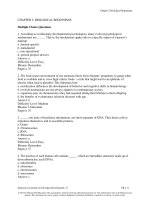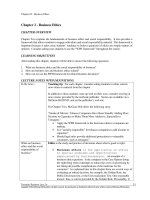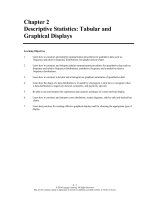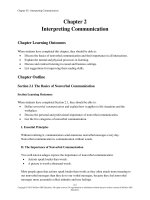Test bank and solution manual of digital business networks (2)
Bạn đang xem bản rút gọn của tài liệu. Xem và tải ngay bản đầy đủ của tài liệu tại đây (132.35 KB, 6 trang )
Chapter 1
Elements of Data Communications: Analog and Digital
Chapter Outline
1.1
1.2
1.3
1.4
1.5
1.6
1.7
1.8
1.9
1.10
1.11
1.12
1.13
1.14
1.15
The Business Benefit
Learning Objectives
The Changing World of Communications
Five Phases of Data Communication Evolution
Defining Data Communications
Protocols
The Ethical Perspective
Standards
Standard Setting Bodies
Chapter Summary
Keywords
Short-Answer Questions
Hands-On Projects
Research in Brief
Topic in Focus: A Closer Look at the IEEE
Learning Objectives
■ Identify five phases in the evolution of data communications.
■ Explain the difference between data communications and telecommunications.
■ Understand what a protocol is and why protocols are used.
■ Recognize the importance of standards and standards-setting bodies.
■ Identify the OSI and TCP/IP networking models.
Chapter Summary
Five phases characterize the evolution of data communications over the past five decades: (1)
digitization, (2) expansion, (3) deregulation, (4) Internet as a common tool, and (5) pervasive
computing. Technology continues to change, altering our definition of what is meant by
“communications.” Data communications is a subset of telecommunications. Whereas
telecommunications involves such technologies as telephony and television, traditional data
communications is more concerned with the transmission of data between computers and
computer networks. In the transmission of data from one location to another, data are first
transformed using binary coding schemes. Binary coding schemes use the binary digits 0 and 1,
which are called bits, to represent data.
Data communications uses protocols, or rules, that establish how the communications occur.
There are many different types of protocols that fulfill different purposes and functionalities.
Protocols state how the data are to be formatted, how the format is to be interpreted, the rate at
which the data are to be transmitted, and whether communications between two devices can be
established. Protocols become established or defined through a standards process. Both formal
and informal standards exist. The trend is for standards to be open and publicly available for all
to use. There are numerous standards-setting bodies; many of them are nongovernmental, private
nonprofit organizations.
Networks have both physical and logical components—respectively, the hardware devices that
compose them and the software that drives them. Networks are also based on models. Two major
models used in data communications are the Open Systems Interconnection, or OSI, model and
the Transmission Control Protocol/Internet Protocol, or TCP/IP, model.
Keywords
ARPANET 4
Binary 6
Data communications 6
De facto standard 9
Deregulation 4
Digitization 3
Encoding scheme 7
Internet 5
IPv4 5
IPv6 5
Nonproprietary 9
Pervasive technology 5
Proprietary 3
Protocol 7
Standards 9
Telecommunications 6
Telemetry 5
Short-Answer Questions
1. What are open standards, and what, if any, are the advantages of such standards?
Open standards are a nonproprietary standard that establishes the essential rules, functionalities,
and operations a protocol must fulfill.
2. What is a protocol and why would one be used? Provide an example of a technological
protocol or a society-based protocol.
Protocols are the rules that determine how devices communicate. Language protocols, called
rules of grammar, make it possible for people who speak and read the same language to
understand one another.
3. How do formal standards differ from de facto standards?
Unlike de facto standards, formal standards are those standards that have been authorized by
either an officially recognized body or by law and regulation.
4. What are the five phases associated with the evolution of data communication networks?
1. Digitization in the 1960s.
2. Growth of data communications in the 1970s.
3. An era of deregulation in the 1980s.
4. The Internet as a common tool in the 1990s.
5. Pervasive computing in the 2010s.
5. With what scale of network is the IEEE associated?
Local area networks.
6. What organization is the principal standards-setting body in the United States?
The American National Standards Institute (ANSI).
7. What is an encoding scheme?
An encoding scheme is a way of transforming one type of data or information into another.
8. What is telemetry?
Telemetry is the wireless transmission and reception of data for the purpose of remotely
monitoring environmental conditions or equipment parameters.
Hands-On Projects, Research in Brief, and Case Study
Answers for these three text elements will vary depending on what an individual student or study
group elects for these assignments. Assignments should be evaluated for relevancy, accuracy,
content, and appropriate use of language. The case study in particular lends itself to a small
group project.
Chapter 2
Networking Models: OSI and TCP/IP
Chapter Outline
2.1
2.2
2.3
2.4
2.5
2.4
2.5
2.6
2.7
2.8
2.11
2.12
2.13
2.14
2.15
2.16
The Business Benefit
Learning Objectives
Networking Models
Open Architectures
Layered Architectures
Open Systems Interconnection (OSI)
The Ethical Perspective
Transmission Control Protocol/Internet Protocol (TCP/IP)
Networking Categories
Chapter Summary
Keywords
Short-Answer Questions
Hands-On Projects
Research in Brief
Case Study Questions
Topic in Focus: How the Layers Work
Learning Objectives
■ Explain networking models.
■ Describe open architectures.
■ List the benefits of layered architectures.
■ Understand the OSI networking model.
■ Understand the TCP/IP networking model.
■ Identify four general categories of networks.
Chapter Summary
Networks have both physical and logical components: the hardware devices that compose them
and the software that drives them. Networks are also based on models. Open architecture models
have some of the same advantages as open standards. Two major models used in data
communications are the open systems interconnection, or OSI, model and the transmission
control protocol/Internet protocol, or TCP/IP, model.
The two models share several characteristics, and each model is well established and accepted by
the data and telecommunications industries. One of the most important features they share is that
both models are based on the concept of layered architectures. A model is based on theory. The
theoretical model must then be implemented into a physical data communications network. In
general, a network falls into one of four categories, based on the network’s characteristics. A
local area network (LAN) is usually contained within a limited geographic area. A backbone
network (BN) is usually a high-speed circuit that connects the various LANs within an
enterprise. A metropolitan area network (MAN) can connect BNs and LANs. Wide area
networks (WANs) are used to transport data over great geographic distances, such as across a
state, a country, or even the globe.
Keywords
Application layer 17
Backbone network (BN) 22
Cloud 24
Common carrier 24
Compression 18
Data link layer 18
Encryption 18
Enterprise 22
Layer stack 17
Layered architecture 16
Local area network (LAN) 22
Logical addressing 18
Metropolitan area network (MAN) 23
Network layer 18
Networking model 15
Open architecture technology 16
Open system interconnection (OSI) model 16
Physical layer 19
Presentation layer 18
Session layer 18
Transmission control protocol/Internet protocol (TCP/IP) model 16
Transport layer 18
Wide area network (WAN) 24
Short-Answer Questions
1. What are open standards, and what, if any, are the advantages of such standards?
Open standards are a nonproprietary standard that establishes the essential rules, functionalities,
and operations a protocol must fulfill.
2. In general, why would a layered architecture be viewed as beneficial?
Each layer within a model has its own particular and specific responsibilities and functionalities.
As such a given layer does not need to be informed as to how other layers function.
3. What is a protocol and why would one be used?
Protocols are the rules that determine how devices communicate such that a sending and
receiving device are able to exchange data and information.
4. What are the four different types of networks?
1. Local Area Networks.
2. Backbone Networks.
3. Metropolitan Area Networks.
4. Wide Area Networks.
5. How many layers make up the OSI model?
Seven layers make up the OSI model.
6. Which layer in the TCP/IP model is closest in alignment with the OSI model?
The physical layer is closest in alignment with the OSI model.
7. What is the purpose of the application layer in the TCP/IP model?
This layer is also sometimes referred to as the process layer and is where a protocol stack
interfaces with processes on a host machine, enabling that host to communicate across the
network.
8. What is the largest scale networking category?
Wide Area Network is the largest scale networking category.
Hands-On Projects, Research in Brief, and Case Study
Answers for these three text elements will vary depending on what an individual student or study
group elects for these assignments. Assignments should be evaluated for relevancy, accuracy,
content, and appropriate use of language. The case study in particular lends itself to a small
group project.









